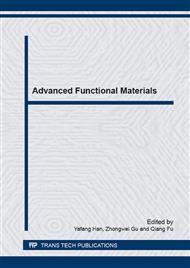p.359
p.367
p.373
p.379
p.385
p.390
p.396
p.401
p.407
Controlled Release of Growth Factors from Tissue Engineering Scaffolds Made by Positive and Negative Voltage Electrospinning
Abstract:
Emulsion electrospun nanofibrous tissue engineering scaffolds made by conventional positive voltage electrospinning (PVES) have various advantages for growth factor (GF) delivery. But problems such as high initial burst release still exist. Negative voltage electrospinning (NVES) may produce nanofiberous scaffolds that can modulate the release behavior of GFs which bear positive electrical charges. By using either PVES or NVES for emulsion electrospinng, the present study investigated the influence of NVES and applied voltage on the release behavior of a typical GF bearing the positive charge, basic fibroblast growth factor (bFGF), encapsulated in the nanofibers of poly (lactic-co-glycolic acid) (PLGA) scaffolds. Emulsions were firstly prepared by mixing a bFGF-containing aqueous solution and a PLGA solution. They were then subjected to electrospinning under either a positive voltage (10, 15, or 20 kV) or a negative voltage (-10, -15, or-20 kV). The morphology and structure of fibers and scaffolds were subsequently characterized. All scaffolds were nanofibrous and the nanofibers exhibited core-shell structures, with the bFGF-containing water phase forming the fiber core. Scaffolds exhibited the same type of electrical charges as the type of the applied voltage for electrospinning, i.e., scaffold made by PVES showed positive charges while scaffold fabricated by NVES possessed negative charges. The intensity of positive or negative charges borne by scaffolds and their retention time on scaffolds increased with an increase in the absolute value of the applied voltage (⏐V⏐). In vitro bFGF release experiments were conducted for scaffolds made by either NVES or PVES. Results showed that the bFGF release behavior was modulated by NVES.
Info:
Periodical:
Pages:
385-389
Citation:
Online since:
March 2015
Authors:
Price:
Сopyright:
© 2015 Trans Tech Publications Ltd. All Rights Reserved
Share:
Citation:


